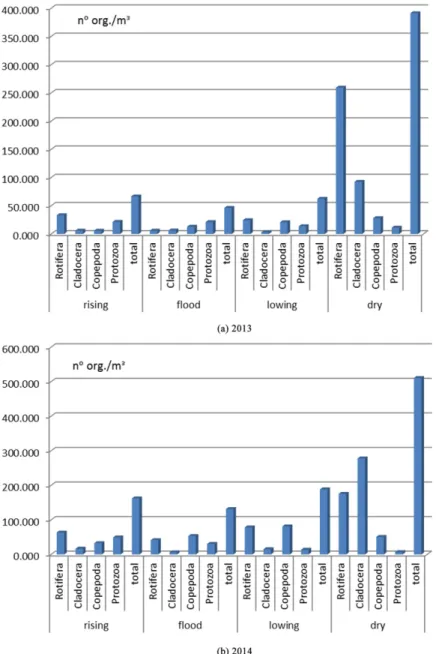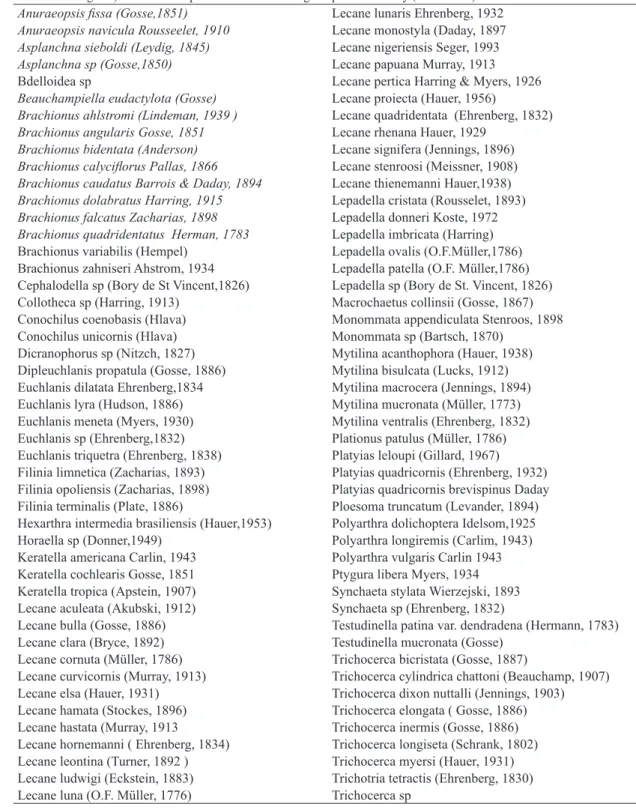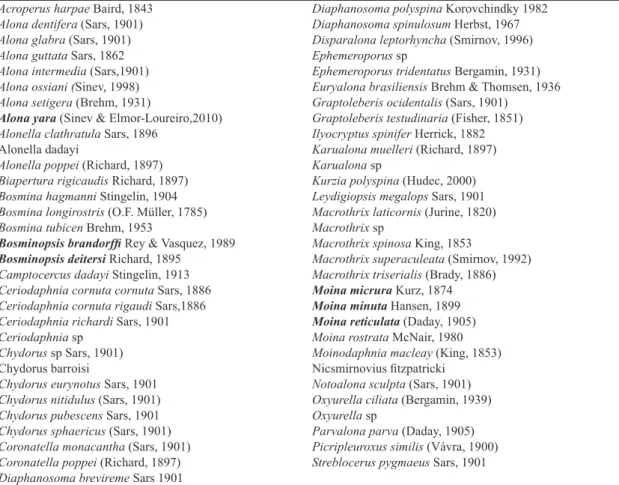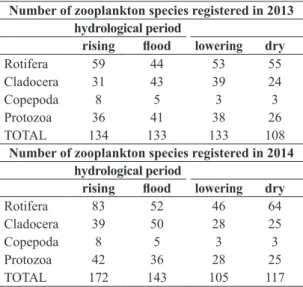Zooplankton community structure of the lower Xingu River (PA)
related to the hydrological cycle
Matsumura-Tundisi, T.
a*, Tundisi, JG.
a,b, Souza-Soares, F.
aand Tundisi, JEM.
a aAssociação Instituto Internacional de Ecologia e Gerenciamento Ambiental – AIIEGA,Rua Bento Carlos, 750, Centro, CEP 13560-660, São Carlos, SP, Brazil
bUniversidade Feevale, Rod. 239, 2755, Vila Nova, CEP 93525-075, Novo Hamburgo, RS, Brazil *e-mail: takako@iie.com.br
Received: September 13, 2015 – Accepted: September 15, 2015 – Distribuited: August 31, 2015 (With 3 Figures)
Abstract
The zooplankton community of the lower Xingu River shows strong fluctuations in species richness and number of organisms during periods of water level fluctuation. Pulses of density and species richness are adapted to the pulses in water flows and water level. This is conected with reproductive strategies of some zooplankton groups. The spatial heterogeneity of the lower Xingu River consisting of braided channels, bedrocks, macrophyte stands, is probably a relevant factor for the species richness of the zooplankton communities, and may be a fundamental factor for the overall aquatic biodiversity of the lower Xingu River.
Keywords: Lower Xingu River, hydrological cycle, zooplankton richness, endemic species, reproductive strategies.
Estrutura da comunidade do zooplancton do Baixo Rio Xingu (PA), em
relação ao ciclo hidrológico
Resumo
A comunidade zooplanctônica do Baixo Rio Xingú apresenta grandes flutuações em riqueza de espécies e na densidade (no org./m3) durante os diferentes períodos de flutuação do nível da água. Pulsos de densidade e de riqueza de espécies, são adaptados e ajustados aos pulsos em nível da água e fluxo. Isto está conectado com as estratégias reprodutivas de certos grupos de zooplancton. A heterogeneidade espacial do baixo Rio Xingú consistindo de canais anastomosados, pedrais, macrófitas aquáticas é provavelmente um fator relevante que impulsiona a riqueza de espécies das comunidades zooplanctõnicas e pode ser um fator fundamental para a alta biodiversidade aquática do Rio Xingú.
Palavras-chave: Baixo Rio Xingú, ciclo hidrológico, riqueza de zooplancton, espécies endêmicas, estratégias reprodutivas.
1. Introduction
It is well known that river discharges have influence in the aquatic biota of rivers due to changes in channel morphology, habitats, deposition of sediments, organisms drift and water level fluctuations. Benthic invertebrates, fishes, zooplankton, periphyton all respond to the temporal variability of the river system, that depends upon the regional hydrological cycle (Petts and Amoros, 1996; Dumont, 2009; Blettler et al., 2012, Abrial et al., 2014).
The lower Xingú River has strong water level fluctuations due to differential discharges throughout the year. Interactions between the zooplankton community and the river discharge in this ecosystem was studied by Brito (2008).
Carvalho (1983) demonstrated that the density and composition of zooplankton in a floodplain lake in Amamzonia is related to water level fluctuation.
The present study is framed into the field of ecological dynamics, in an attempt to provide an insight of the integration of hydrology, ecology and zooplankton community structure. Zooplankton sampling and analysis were performed within an área of 10.000km2 within the framework of the environmental impact assessment of Belo Monte reservoir, in the lower Xingu River carried out by Norte Energia S.A. The zooplankton studies are part of limnological, water quality and aquatic ecology research developed by Associação Instituto Internacional de Ecologia e Gerenciamento Ambiental (AIIEGA, 2015).
above sea level from beggining of March to the end of July; reciding – water leaving the river system and water levels falling from the end of July to the end of October between 26 and 20m above the sea level; low– water level equal or below 20m above sea level from the end of October to mid December.
2. Material and Methods
A general description of the overall sampling strategy adopted for limnological and ecological studies was described by Tundisi et al. (In press, this volume). Figure 1 shows the average monthly flow, total precipitation (monthly) and sampling periods. The four periods of hydrological cycle adopted was: rising (November, December, January)
flood, (February, March, April), lowing (May, June, July) and dry (August, September, October) periods.
A total of 37 stations were distributed along the lower Xingu River including the main chanel, tributaries and igarapés.
3. Results
3.1. Composition, density and richness of zooplankton related to the hydrological cycle
The most abundant group, numerically in all samples was Rotifera. Figure 2a,b show the relative abundance between Rotifera, Cladocera, Copepoda and Protozoa groups occurred in 2013 (Figure 2a) and in 2014 (Figure 2b). Generally the Rotifera independent of the hydrological cycle, represented 40-50% of the total zooplankton. Exception occurred during the high water in 2013 (Figure 2a) where Rotifera was substituted by Tecameba protozoan which dominated the zooplankton (47.4%) and Copepoda (35.3%) especially in this case in the phase of nauplii. Also in the dry period of 2014, Rotifera was outnumberd by Cladocera that represented 48.0% of the total zooplankton whereas Rotifera was 30,0%. The high percentage of Cladocera was due to the very high growth of Bosminopsis deitersi population.
Comparing the absolute density of planktonic organisms (ind/m3) in 2013 and 2014 (Figure 3a, b) there were
higher number of organisms in 2014 with 510,749 org/m3 (Figure 3b) than in 2013 with 391,187org./m3 (Figure 3a). In both cases high density of total zooplankton occurred during the dry period due to the increasing of number of Rotifera, Cladocera and Copepoda.
Tables 1, 2, 3 and 4 refer respectively to the list of species of Rotifera, Protozoa, Cladocera and Copepoda found in the samples of 2013 and 2014.
Among the Rotifera (Table 1), 94 species were registered. The ten (10) more abundant in order of number of individuals were: Brachionus zahniseri (136,868 ind/m3); Polyarthra vulgaris (80,716 ind/m3); Brachionus caudatus (71,194 ind/m3; Lecane proiecta (65,132 m3); Keratella
americana (29,108 ind/m3); Pitygura libera (20,133 ind/m3); Conochilus coenobasis (14,734 ind/m3); Synchaeta stylata (14,699 ind/m3); Filinia limnetica (10,728 ind/m3) e Lecane curvicornis (8,352 ind/m3).
Among Protozoa (Table 2) it was recorded 49 species where the most abundant species were Centropixis aculeata (27,818 ind/m3); Arcella rotundata alta (10,074 ind/m3); Arcella vulgaris (6,156 ind/m3); Difflugia lobostoma (3,625 ind/m3); Arcella gibbosa (3177 ind/m3).
Moina minuta with 15,008 ind/m3; Moina reticulata with 6,188 ind/m3; Moina micrura with 4,876 ind/m3; Ilyocryptus spinifer with 1,462 ind/m3; Alona yara with 1,209 ind/m3 and Bosminopsis brandorffi with 1,013 ind/m3.
For the Copepoda group (Table 4) there were identified four species of Cyclopoida: Mesocyclops meridianus, Macrocyclops sp, Thermocyclops minutus and Thermocyclops inversus and six species of Calanoida: Pseudodiaptomus gracilis, Notodiaptomus paraensis, Notodiaptomus dahli, Notodiaptomus oliverai, Notodiaptomus isabelae and Notodiaptomus jatobensis. The analysis for this group was carried out separating for Cyclopoida and Calanoida including the phase of naupliae, copepodits and adult.
Table 5 shows zooplankton species richness recorded at the four phases of the hydrological cycle, showing more richness in the rising and flood periods than lowering and
dry periods for both years 2013/2014. The decreasing of number of species during the dry period is clear for all the groups especifically for cladocerans and copepods. 3.2. Endemic species of the Amazonian region
Table 1. List of Rotifera species recorded in the lower Xingu River. The subscribed species were the most abundant (more than 50.000 org./m3) and more frequent occorrence during the period of study (2013-2014).
Anuraeopsis fissa (Gosse,1851) Lecane lunaris Ehrenberg, 1932 Anuraeopsis navicula Rousseelet, 1910 Lecane monostyla (Daday, 1897 Asplanchna sieboldi (Leydig, 1845) Lecane nigeriensis Seger, 1993
Asplanchna sp (Gosse,1850) Lecane papuana Murray, 1913
Bdelloidea sp Lecane pertica Harring & Myers, 1926
Beauchampiella eudactylota (Gosse) Lecane proiecta (Hauer, 1956)
Brachionus ahlstromi (Lindeman, 1939 ) Lecane quadridentata (Ehrenberg, 1832) Brachionus angularis Gosse, 1851 Lecane rhenana Hauer, 1929
Brachionus bidentata (Anderson) Lecane signifera (Jennings, 1896) Brachionus calyciflorus Pallas, 1866 Lecane stenroosi (Meissner, 1908) Brachionus caudatus Barrois & Daday, 1894 Lecane thienemanni Hauer,1938) Brachionus dolabratus Harring, 1915 Lepadella cristata (Rousselet, 1893) Brachionus falcatus Zacharias, 1898 Lepadella donneri Koste, 1972 Brachionus quadridentatus Herman, 1783 Lepadella imbricata (Harring) Brachionus variabilis (Hempel) Lepadella ovalis (O.F.Müller,1786) Brachionus zahniseri Ahstrom, 1934 Lepadella patella (O.F. Müller,1786) Cephalodella sp (Bory de St Vincent,1826) Lepadella sp (Bory de St. Vincent, 1826) Collotheca sp (Harring, 1913) Macrochaetus collinsii (Gosse, 1867)
Conochilus coenobasis (Hlava) Monommata appendiculata Stenroos, 1898
Conochilus unicornis (Hlava) Monommata sp (Bartsch, 1870)
Dicranophorus sp (Nitzch, 1827) Mytilina acanthophora (Hauer, 1938) Dipleuchlanis propatula (Gosse, 1886) Mytilina bisulcata (Lucks, 1912) Euchlanis dilatata Ehrenberg,1834 Mytilina macrocera (Jennings, 1894)
Euchlanis lyra (Hudson, 1886) Mytilina mucronata (Müller, 1773)
Euchlanis meneta (Myers, 1930) Mytilina ventralis (Ehrenberg, 1832) Euchlanis sp (Ehrenberg,1832) Plationus patulus (Müller, 1786) Euchlanis triquetra (Ehrenberg, 1838) Platyias leloupi (Gillard, 1967) Filinia limnetica (Zacharias, 1893) Platyias quadricornis (Ehrenberg, 1932) Filinia opoliensis (Zacharias, 1898) Platyias quadricornis brevispinus Daday Filinia terminalis (Plate, 1886) Ploesoma truncatum (Levander, 1894) Hexarthra intermedia brasiliensis (Hauer,1953) Polyarthra dolichoptera Idelsom,1925
Horaella sp (Donner,1949) Polyarthra longiremis (Carlim, 1943)
Keratella americana Carlin, 1943 Polyarthra vulgaris Carlin 1943 Keratella cochlearis Gosse, 1851 Ptygura libera Myers, 1934 Keratella tropica (Apstein, 1907) Synchaeta stylata Wierzejski, 1893 Lecane aculeata (Akubski, 1912) Synchaeta sp (Ehrenberg, 1832)
Lecane bulla (Gosse, 1886) Testudinella patina var. dendradena (Hermann, 1783)
Lecane clara (Bryce, 1892) Testudinella mucronata (Gosse)
Lecane cornuta (Müller, 1786) Trichocerca bicristata (Gosse, 1887)
Lecane curvicornis (Murray, 1913) Trichocerca cylindrica chattoni (Beauchamp, 1907) Lecane elsa (Hauer, 1931) Trichocerca dixon nuttalli (Jennings, 1903) Lecane hamata (Stockes, 1896) Trichocerca elongata ( Gosse, 1886)
Lecane hastata (Murray, 1913 Trichocerca inermis (Gosse, 1886)
Lecane hornemanni ( Ehrenberg, 1834) Trichocerca longiseta (Schrank, 1802) Lecane leontina (Turner, 1892 ) Trichocerca myersi (Hauer, 1931) Lecane ludwigi (Eckstein, 1883) Trichotria tetractis (Ehrenberg, 1830)
Lecane luna (O.F. Müller, 1776) Trichocerca sp
among copepods are considered endemic species of the Amazon region, because they were not registered in any other geographical regions or hydrographic basins of Brazil.
Pseudodiaptomus gracilis found at two stations in the lower Xingu River (Matsumura-Tundisi and Tundisi, 2007), is probably an endemic species of the Amazon region, restricted to it. The species is living in
Table 2. List of Protozoa species recorded in the sampling of the lower Xingu River during the period 2013-2014. The subscribed species were the most abundant species (more than 3000 ind/m3) that occurred in that period.
Arcella artocrea Leidy, 1876 Difflugia acuminata Ehrenberg, 1838 Arcella conica (Playfair, 1918) Difflugia acutissima Deflandre, 1931 Arcella costata Ehrenberg, 1847 Difflugia bidens Penard, 1902
Arcella crenulata Deflandre, 1928 Difflugia brevicolla Cash & Hopkins, 1909 Arcella dentata Ehrenberg, 1838 Difflugia bryophila (Penard, 1902) Arcella discoides Ehrenberg, 1871 Difflugia corona Wallich, 1864
Arcella gibbosa Pénard 1890 Difflugia cylindrus (Thomas)Ogden, 1893
Arcella hemisphaerica Perty, 1852 Difflugia distenda Ogden, 1983 Arcella hemisphaerica undulata Deflandre, 1928 Difflugia elegans Pénard 1890 Arcella megastoma Pénard, 1913 Difflugia gramen Pénard, 1902 Arcella mitrata Leidy, 1879 Difflugia lacustris (Penard,1899)
Arcella rotundata alta Playfair, 1918 Difflugia lanceolata (Penard, 1890)
Arcella vulgaris Ehrenberg, 1830 Difflugia litophila Pénard, 1902 Arcella vulgaris undulata Deflandre, 1928 Difflugia lobostoma Leidy, 1877
Centropyxis aculeata (Ehrenberg, 1830) Difflugia lobostoma multilobata Gauthier-Liève & Thomas, 1958 Centropyxis aculeata oblonga Deflandre, 1929 Difflugia mammillaris Pénard, 1902
Centropyxis aerophila Deflandre, 1929 Difflugia microclaviformis (Kourov, 1925) Centropyxis cassis (Wallich, 1864) Difflugia oblonga Ehrenberg, 1838 Centropyxis constricta (Ehrenberg, 1841) Difflugia penardi Hopkinson,1909 Centropyxis discoides Pénard, 1890 Difflugia urceolata Carter 1864 Centropyxis ecornis (Ehrenberg, 1841) Diflugia sp
Centropyxis gibba Deflandre, 1929 Lesquereusia sp (Schlumberger, 1845) Centropyxis marsupiformis (Wallich) Deflandre, 1929 Pontigulasia sp (Rhumbler, 1896)
Centropyxis platystoma Pénard, 1890 Protocucurbitella coroniformis Gauthier-Liève & Thomas, 1960 Difflugia achlora Pénard, 1902
Table 3. List of Cladocera species found in the lower Xingu River, during the period 2013-2014. The subscribed species were the most abundant e frequent species that occurred on the sampling of that períod.
Acroperus harpae Baird, 1843 Diaphanosoma polyspina Korovchindky 1982 Alona dentifera (Sars, 1901) Diaphanosoma spinulosum Herbst, 1967 Alona glabra (Sars, 1901) Disparalona leptorhyncha (Smirnov, 1996)
Alona guttata Sars, 1862 Ephemeroporus sp
Alona intermedia (Sars,1901) Ephemeroporus tridentatus Bergamin, 1931) Alona ossiani (Sinev, 1998) Euryalona brasiliensis Brehm & Thomsen, 1936 Alona setigera (Brehm, 1931) Graptoleberis ocidentalis (Sars, 1901)
Alona yara (Sinev & Elmor-Loureiro,2010) Graptoleberis testudinaria (Fisher, 1851) Alonella clathratula Sars, 1896 Ilyocryptus spinifer Herrick, 1882
Alonella dadayi Karualona muelleri (Richard, 1897)
Alonella poppei (Richard, 1897) Karualona sp
Biapertura rigicaudis Richard, 1897) Kurzia polyspina (Hudec, 2000) Bosmina hagmanni Stingelin, 1904 Leydigiopsis megalops Sars, 1901 Bosmina longirostris (O.F. Müller, 1785) Macrothrix laticornis (Jurine, 1820)
Bosmina tubicen Brehm, 1953 Macrothrix sp
Bosminopsis brandorffi Rey & Vasquez, 1989 Macrothrix spinosa King, 1853
Bosminopsis deitersi Richard, 1895 Macrothrix superaculeata (Smirnov, 1992) Camptocercus dadayi Stingelin, 1913 Macrothrix triserialis (Brady, 1886) Ceriodaphnia cornuta cornuta Sars, 1886 Moina micrura Kurz, 1874 Ceriodaphnia cornuta rigaudi Sars,1886 Moina minuta Hansen, 1899 Ceriodaphnia richardi Sars, 1901 Moina reticulata (Daday, 1905)
Ceriodaphnia sp Moina rostrata McNair, 1980
Chydorus sp Sars, 1901) Moinodaphnia macleay (King, 1853)
Chydorus barroisi Nicsmirnovius fitzpatricki
Chydorus eurynotus Sars, 1901 Notoalona sculpta (Sars, 1901) Chydorus nitidulus (Sars, 1901) Oxyurella ciliata (Bergamin, 1939)
Chydorus pubescens Sars, 1901 Oxyurella sp
Table 4. Copepoda species registered in sampling from lower Xingu River made in 2013 and 2014.
CYCLOPOIDA
Macrocyclops sp Claus, 1893
Thermocyclops minutus (Lowndes), 1934 Thermocyclops inversus Kiefer, 1936 Mesocyclops meridianus (Kiefer), 1926 CALANOIDA
Notodiaptomus jatobensis (Wright), 1936 Notodiaptomus isabelae (Wright), 1936
Notodiaptomus oliverai Matsumura-Tundisi et al.,2010 Notodiaptomus dahli (Wright), 1936
Notodiaptomus paraensis Dussart & Robertson, 1984 Pseudodiaptomus gracilis (F.Dahl, 1894)
Table 5. Richness of zooplankton species in different phases of hidrological cycle.
Number of zooplankton species registered in 2013 hydrological period
rising flood lowering dry
Rotifera 59 44 53 55
Cladocera 31 43 39 24
Copepoda 8 5 3 3
Protozoa 36 41 38 26
TOTAL 134 133 133 108
Number of zooplankton species registered in 2014 hydrological period
rising flood lowering dry
Rotifera 83 52 46 64
Cladocera 39 50 28 25
Copepoda 8 5 3 3
Protozoa 42 36 28 25
TOTAL 172 143 105 117
4. Discussion
The zooplankton assemblage found in this research showed consistent results in the sampling periods of 2013 and 2014. In general species richness increased during the rising and flood periods being the main contributors Rotifera and Protozoa. On the other hand density increases during the dry period. This was due specially to the groups of Cladocera and Copepoda that have different mechanisms of reproduction than Rotifera and Protozoa. Cladocerans and copepods require an environment less turbulent for its reproduction and development of their populations and they could find this condition during the dry period. It is knowm that some species of cladocerans and copepods produce resting eggs that are deposited in the sediment and at favourable conditions they outburst increasing their density. This fact, probably occurred with Cladocera during the dry period of 2014, where the high density showed by Bosminopsis deitersi was responsible for a high density of total zooplankton.
As pointed out by Lodge (1987) comparative studies that are conducted in a variety of habitats are relevant to demonstrate the community dynamics. Therefore the strategy of sampling in several sites of the lower Xingu River was consistent in revealing the dynamics of zooplankton communities.
Greenwood and Richard-Coulet (1996) discussed how the distribution of species in a river ecosystem is related to adaptative strategies to physical parameters such as, water temperature, flow velocity, water level fluctuations, optiminization of food resources and available living space habitat.
The lower Xingu River is a highly heterogeneous environment consisting of several stretches with bedrocks, macrophyte vegetation and a extensive network of tributaries, (igarapés) wide and complex. A variety of aquatic environments occurs in the river created by several degrees of conectivity and mosaics. This is a factor that enhances diversity of communities, adapted to various conditions of hydraulic stresses, flows, thermal patterns and substrate. The use of a extensive series of measurements in hydrology, water flows, diversity of habitats and sampling of zooplanktonic community was fundamental to understand the spatial and temporal variation of the density/species richness problem. The spatial heterogeneity promotes a succession of communities which take advantage of food habitats. Braided channels such as those found in the lower Xingu river have dense stands of macrophytes (See Abe et al., In press, this volume) that provide protection from disturbances, surfaces for periphyton growth, and abundant food diversity. Macrophytes stands create an aquatic microclimate that affect distribution of organisms and species richness. The quality and quantity of detritus produced in the bedrocks and macrophyte stands and transported by the river offers a wide variety of food available to rotifers, protozoan and other zooplankton species. Open water habitats, dense macrophytes stands, regions of low flows and stagnant waters, are rich in diverse environments enhancing zooplankton diversity. Therefore the spatial heterogneity promotes a diversity of habitats and conditions that enhances zooplankton diversity and species richness. These species are distributed spatially during rising and flood periods, adapting their reproductive strategies to the hydraulic conditions, flows and spatial heterogeneity. This is conspicuous for Cladocera and Copepoda species. Rotifers and protozoan that have not resting eggs, for example shows continuous reproduction strategies during the whole hydrological cycle.
Density of zooplankton decreases during rising and flood period during to the higher dilution. Thus the river discharge, the extensive morphological and hydrological alterations that occur in the lower Xingu river are probably the main cause of the high species richness in this ecosystem.
functioning as a substitute of the floodplain lakes in the várzea (Junk et al., 1989). The zooplankton community is only one example of an ample process that involves all the benthic, fish, periphyton and phytoplankton communities. Significant differences in the aquatic communities at the distinct stages of the hydrological regime occur.
Why there are several endemic species in the aquatic biota of the Amazon River? The hydrogeochemistry of the Amazon basin shows many rivers, lakes and freshwater ecosystems with low conductivity waters and a low degree of mineralization. It is well known from the literature that ionic composition, pH, conductivity of freshwaters are fundamental for the physiological functioning of species of fishes, and aquatic invertebrates in general. This could be one reason for the high degree of endemicity of the freshwater biota in Amazon. However the Amazon region is composed of several varied habitats with differing conditions (Furch, 1984). Several geographical barriers, such as the spatial heterogeneity of the region, the magnitude of water level fluctuations and the interactions terrestrial/aquatic ecosystem may be the cause of geographical isolation and therefore promote endemicity.
4.1. Future changes in zooplankton
This paper describes the ecological dynamics of the zooplankton communities in the river ecosystems. With the construction of the two reservoirs at Belo Monte power plant some changes will occur. These can be related to the loss of heterogeneity in habitats considering the flood of the bedrocks and macrophyte stands. Probably the reservoirs will favour the growth and development of Copepoda and Cladocera species that have more conditions to reproduce and growth in lentic environments. Changes in the foodchain can also be expected, since phytoplankton can predominate as food available for zooplankton in the reservoirs. Therefore the zooplankton can change from a lotic community to a lentic community with a predominance of pelagic species. Dumont (2009) reported changes in the diversity and species richness of Nile River zooplankton after the start of operation of the Aswan high dam.
Acknowledgements
The authors are grateful to the staff of AIIEGA, that participated at the field work and laboratory analysis of the Project Limnological studies and water quality evaluation of the Xingu River.
References
ABE, DS., SIDAGIS-GALLI, C., MATSUMURA-TUNDISI, T., TUNDISI, JEM., BLANCO, FP., FARIA, CRL. and TUNDISI, JG., In press. Additional list of species of aquatic macrophytes in the lower basin of the Xingu River. Brazilian Journal of Biology = Revista Brasileira de Biologia.
ABRIAL, E., RABUFFETTI, AP., ESPÍNOLA, LA., AMSLER, AR., BLETTLER, MCM. and PAIRA, AR., 2014. Influence of hydrological changes on the fish community in two lotic
environments of the Middle Paraná Floodplain, Argentina. Aquatic Ecology, vol. 48, no. 3, p. 337-349. http://dx.doi.org/10.1007/ s10452-014-9488-x.
Associação Instituto Internacional de Ecologia e Gerenciamento Ambiental – AIIEGA, 2015. Limnological and water quality studies in the Xingu River in the área of influence of Belo Monte Power Plant. São Carlos: IIEGA. 180 p + anexos. Report, VII and VIII. BITTENCOURT, MM. and AMADIO, SA., 2007. Proposta para identificação rápida dos períodos hidrológicos em áreas de várzea do Rio Solimões – Amazonas nas proximidades de Manaus. Acta Amazonica, vol. 37, no. 2, p. 307-312. http://dx.doi.org/10.1590/ S0044-59672007000200019.
BLETTLER, MCM., AMSLER, ML. and DRAGO, IE., 2012. Hydraulic factors controlling the benthic invertebrate distribution within and among dunes of middle Paraná River (Argentina) and sampling techniques. Journal of South American Earth Sciences, vol. 35, p. 27-37. http://dx.doi.org/10.1016/j.jsames.2011.11.003. BRITO, CSA., 2008. Variação espaço temporal do zooplancton em diferentes ambientes do médio Rio Xingú, PA. Belém: Universidade Federal do Pará. 79 p. Masters Dissertation in Animal Science. CARVALHO, MC., 1983. Efeitos da flutuação do nível da água sobre a densidade e composição do zooplancton em um lago da varzea da Amazonia, Brasil. Acta Amazonica, Manaus, vol. 13, no. 5-6, p. 715-724.
DUMONT, HJ., 2009. The crustacean zooplankton (Copepoda, Branchiopoda) Atynid Decapoda and Syncaride of the Nile Basin. In DUMONT, HJ. (Ed.). The Nile: origin environments and human use. Berlin: Springer. p. 547-562.
FURCH, F., 1984. Water chemistry of the Amazon basin. The distribution of chemical elements among freshwaters. In SIOLI, H. (Ed.). The Amazon. Limnology and handscape ecology. Dordrecht: Dr. W. Junk Publishers. p. 168-199. Monographae Biologicae, no. 56.
GREENWOOD, MT. and RICHARD-COULET, M., 1996. Aquatic Invertebrates. In PETTS, GE. and AMOROS, C. (Eds.). Fluvial hydrosystems. London: Chapman & Hall. p. 138-166. JUNK, WJ., BAYLEY, PB. and SPUNKS, RE., 1989. The flood pulse concept in river flood plain systems. Canadian Special Publication of Fisheries and Aquatic Sciences, vol. 196, p. 110-127. LODGE, D., 1987. Spatial heterogeneity and habitat interactions in lake communities. In CARPENTER, SR. (Ed.). Complex interactions in lake communities. Berlin: Springer-Verlag. p. 181-208.
MATSUMURA-TUNDISI, T. and TUNDISI, JG., 2007. Occurrence of Pseudodiaptomus gracilis (F.Dahl, 1894), Copepoda, Calanoida in amamzoniam fresh waters. Brazilian Journal of Biology = Revista Brasileira de Biologia, vol. 67, no. 3, p. 585-586. http:// dx.doi.org/10.1590/S1519-69842007000300029. PMid:18094847. PETTS, GE. and AMOROS, C., 1996. Fluvial hydrosystems. London: Chapman & Hall. 322 p.





